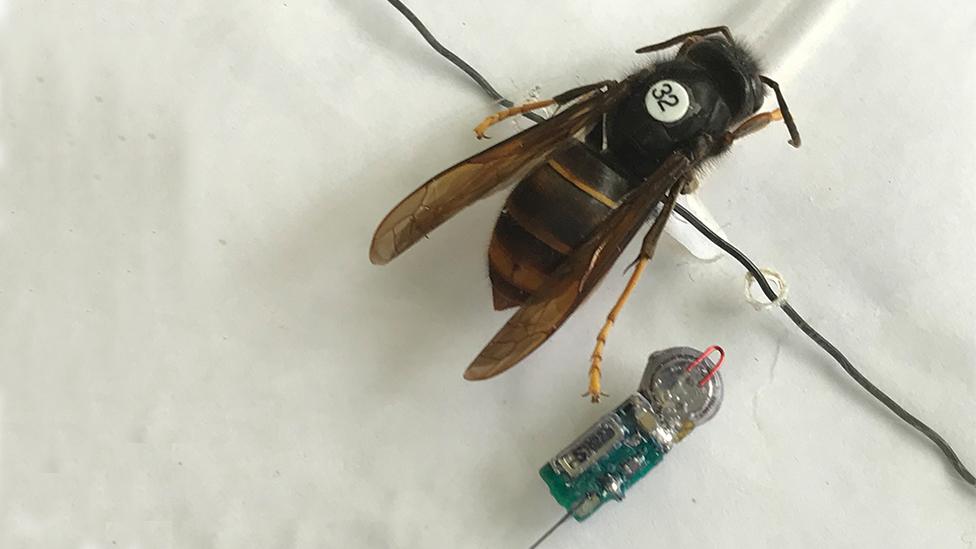Asian hornet scientists in 'breakthrough' to stop spread
- Published

Dr Kennedy said the hornets could carry the tracking device which could be up to 80% of the insect's weight
Scientists say they have made a breakthrough in the fight to stop the spread of Asian hornets in the UK.
A team from the University of Exeter used electronic radio tags to track the invasive species - which kill and eat bees - to their nests.
Professor Juliet Osbourne said the new technology will help authorities find nests early, which was "vital" to stop them "colonising the UK".
Asian hornets have been seen in Spain, France, the Channel Islands and the UK.
Last year the team, based at the university's Penryn campus in Cornwall, travelled to France and Jersey to conduct tests which aimed to find a quicker method of locating Asian hornet nests so they could be destroyed.

Asian hornet (Vespa velutina)
Queens are up to 3cm (1.2in) in length, while workers are up to 2.5cm (1in).
The hornets have a dark brown or black velvety body, bordered with a fine yellow band.
There is only one band on the hornet's abdomen, with the fourth abdominal segment almost entirely yellow or orange.
They have brown legs with yellow ends.
And they have a black head with an orange-yellow face.
Source: National Bee Unit

Dr Peter Kennedy, who led the research, said the team captured and partially froze hornets in order to place the radio tags on them with a sewing thread.
The team were able to track the insects up to 0.8 miles (1.3km).

Asian hornets pose no greater risk to human health than a British bee or wasp sting
"Our new method of tracking offers a really important new tool to tackle the spread of this invader, providing an efficient means of finding hornets' nests in urban, rural and wooded environments," Dr Kennedy said.
The team were part funded by beekeepers in the South West and the Department for the Environment Food and Rural Affairs (Defra), which is "preparing for future outbreaks" of the invasive species in the UK.
Nicola Spence, Defra deputy director for plant and bee health, said: "This work is key for ensuring a rapid response to Asian hornets when sightings are confirmed."
Over the past decade Asian hornets have spread across western Europe. In 2012 two nests were detected in northern Spain according to Dr Xesus Feas, external from the University of Santiago de Compostela, who says in 2016 this spread to more than 10,000.
The species was first seen in Britain in Gloucestershire in 2016, but there were further sightings in Woolacombe, Devon, last year.
In April, a single hornet was found in Lancashire.
They have also been spotted in Jersey, Guernsey, Alderney and Sark in the Channel Islands.

Studying Asian hornet nests
Scientists use video to study Asian hornet embryo growth
John de Carteret, a former forensic photographer from Jersey, has been filming Asian hornet queens building nests around the island.
He is part of the Jersey Beekeeper's Association, which has been tracking Asian hornets down by hand.
Scientists from Spain, England and Scotland have been viewing Mr de Carteret's footage and say it gives a rare insight into the development of an Asian hornet nest.

- Published4 September 2017

- Published25 August 2017